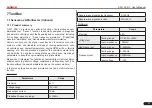
LAUNCH
X-431 PAD V
User's Manual
59
7.2.4.3 Outside the vehicle test
It only applies to battery test and detecting floating electricity will be
ignored while performing battery test.
In Fig. 7-14, tap [Outside the vehicle] to select battery test standard.
The following operation steps are identical to Steps 6 ~ 7 in Chapter
7.2.4.2 Battery test. Please refer to it for details.
7.2.5 Precautions on battery test
For the purpose of getting accurate test results, unless otherwise
special required, all loads need to be power off such as headlamp,
engine etc. before testing battery.
The operating time required for charging system and actuation system
test varies from person to person. If the engine does not start or
accelerate within 30 seconds, the system will prompt you “receiving
timeout” and return to the initial status.
Whether Engine is off or not has no influence on charging and
actuation test result after increased speed is detected, but other loads
need to be powered off.
The accuracy of battery voltage, charging voltage, start voltage is
0.01V in test results; CCA (Cold Cranking Amps) precision is 5CCA.
Generally, charging voltage value is greater than starting voltage.
Charging voltage range is as follows: 13.8--14.5V for domestic vehicle;
13.3--15.5V for imported vehicles. The voltage varies with different
car models, so you have to judge based on related vehicle models.
In general, the DC voltage is stable, but it also varies with different
revolution speed.
Starting voltage range: The value higher than 9.6V is regular,
otherwise it is too low. Due to different situations, whether the starting
voltage is higher or not does not mean the vehicles or batteries are
faulty. For detailed faults, other special equipments are needed.
To validate the accuracy of the value, the best method is to collect
the signals of starting and charging voltage and observe it on an
oscillometer.
Generally, the voltage is lower than 11V for the bad cell battery, but it
is possible that the battery is completely exhausted or has a serious
low capacity. In this case, just recharge your battery. Bad cell always
happens when the loads on a stopping vehicle are turned on for a long
time.
Please note that it is normal for quick detecting of “Increase speed”
because it follows the theory of detecting “Increase speed”: If the
detected voltage is higher than the previous battery test voltage, the
system will prompt you a message of “Engine has been speeded”
It has no influence on test result in the event that engine’s output
voltage or engine revolution is not very stable. No matter whether
the vehicle is accelerated or not, the output voltage only differs within
0.2V.
While doing inside the vehicle test, Kelvin clip is always found to be
in poor contact. To remain it in good contact, please shake it several
times before testing. Take down the battery connector, and test it
again, the value probably varies. The deviation may arise from battery
connector.
Pay more attention to connect the clip. The battery poles connect
with conductor, which makes the clip has a poor connection when
testing battery. A tolerance of dozens of CCA occurs if the clip is out of
position, or oil, dust attaches on the pole. The gear and main body of
clip should be fully matched with battery poles.
















































